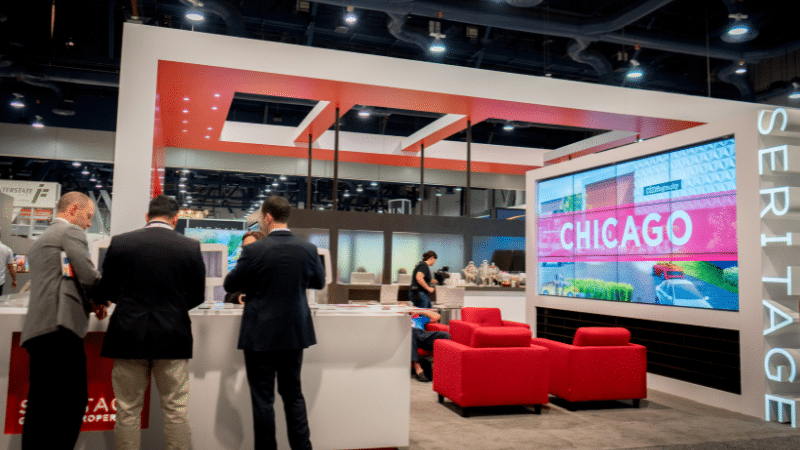Get trade show ready: A first-time exhibitor checklist
At a Glance
Before the event, create a post-show email that’s ready to send once the show closes.
Determine how you will measure success at the show.
Test all equipment, event tech, and any activations BEFORE the show opens.
Designate a point person or vendor to oversee teardown, packing, and shipping.
Feeling like a trade show rookie? Planning your exhibit presence and the logistics involved can feel overwhelming. But the reward of bringing your brand to life at a trade show is creating a branded destination to connect face-to-face with customers and prospects.
If you’re ready to go (trade show) pro, use our handy checklist of priorities and helpful tips to conquer your first exhibition.
This starter kit breaks down the key tasks before, during, and after the show to make the most of your investment.
Pre-Show
- Begin planning 3-6 months ahead of the event.
- Create an action plan and designate roles and responsibilities.
- Read the show manual thoroughly so you’re aware of basic event information, rules and regulations (they vary by city), important deadlines, and necessary order forms.
- Make note of the show’s official contractors — these companies provide booth services at the event and can help your event experience run smoothly.
TIP: The official service contractor is the show management’s partner and exclusive provider of rigging, furniture rental, signage, labor, carpet, displays, transportation, and material handling. In some cases, official service contractors also provide audiovisual, electrical, and utilities.
- Align the event goals with your organization’s goals — showing how the event investment contributes to those key objectives ensures a slate of future events.
- Use these goals to outline how you’ll measure success at the show.
- Define your target audience along with their interests and needs — how does your product or service provide solutions and how can you showcase them in the booth?
- Build your budget: Typical costs include travel, registration, exhibit space rental, booth design/activations, show services (carpet/flooring, furniture, audio visual, electrical, lead retrieval, etc.), shipping/transportation, marketing, giveaways, and sponsorships.
TIP: When earmarking funds for booth space, travel, shipping, etc., remember to budget for smaller yet important items such as graphic design, promotion, and other miscellaneous needs that could arise on-site.
- Determine your booth plan: Will you rent, build, use existing structures, or a hybrid?
- Design a memorable in-booth experience that highlights your products/services and meets the needs of your target audience.
- Build and train a varied booth team that includes salespeople as well as other representatives across the organization.
- Market your presence: Get the word out through various marketing channels reaching your audience and support your investment by including all the details on your organization’s website (and social media!) so your customers can find you easily.
- Confirm inbound shipping: Any shipments sent from your facility to the event — these require certified weight tickets.
- Confirm outbound shipping: Any shipments sent from the show back to your facility or on to the next show — these require a material handling agreement.
- Choose an outbound shipping provider — preferably one experienced with trade show transportation experience.
- Make travel arrangements and pad arrival/departure times to allow for booth setup and teardown schedules.
- Record all order confirmations and shipments with tracking numbers to reference on-site.
- Schedule a pre-show meeting with booth staff and any other company representatives attending the event to go over show priorities, activations, and show success measures.
TIP: Shipping to the advance warehouse up to 30 days before exhibitor move-in can save costs. Choosing advance shipments also ensures packages arrive in time for move-in.
During Show
- Before show opening, check out your space to ensure all shipments have arrived and confirm all orders have been completed or are in process.
- If you hired labor, check in at the service desk to ensure your work order is in process. While you’re there, confirm teardown labor, too.
- Test, test, test! Make sure all equipment, event tech, and any activations are working properly BEFORE show opening.
- Label all empty boxes and containers you’ll need for teardown before they’re taken to the warehouse.
TIP: Before containers are taken to storage, remove every item needed for the show because you won’t have access to them during the event.
Post-Show
- Collect all final leads, business cards, and notes gathered from staff during the show.
- Depending on booth size and complexity, you may designate a point person or vendor to oversee teardown, material packing, and shipping.
- Complete a Material Handling Agreement (MHA) for all outbound shipments (each destination requires its own MHA) and return to the Exhibitor Service Center.
- Apply labels to every container and/or box you plan to ship.
- Check with the service desk and hired vendors for all final invoices.
- Evaluate success at the show – consider an on-site or post-show survey to gauge effectiveness of the marketing campaign and in-booth activations. Remember to survey your team as well as your customers to improve your next show.
- Follow up with leads and contacts to keep the conversation going. Make sure the correspondence happens no later than a week following the event.
TIP: Before the event, create a post-show email that’s ready to send once the show closes — thank visitors for stopping by, recap key messages, and include a clear and enticing call-to-action.
With all the new terminology, paperwork, and advance work required, you can feel adrift in the trade show planning process. But navigating the steps with a little insider guidance will prepare you to generate more leads, build bigger buzz, and deliver better results for your first exhibit adventure.
Need more help with exhibit planning?
Our solution experts are here to help with strategy, custom creative, event technology, and more!


